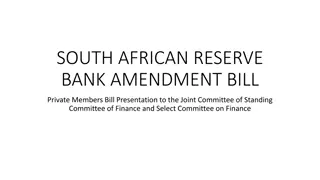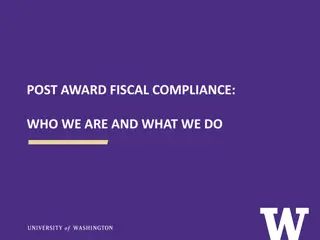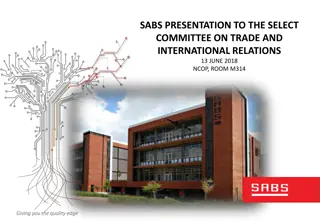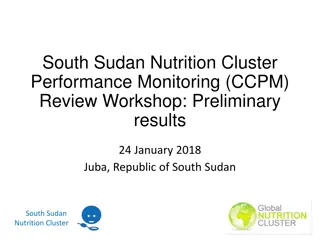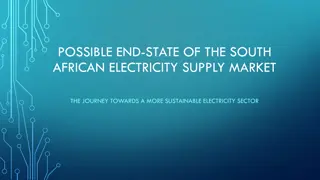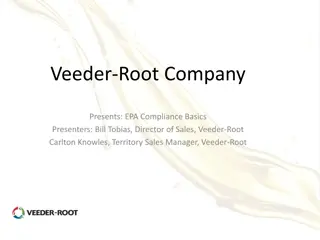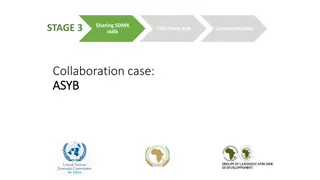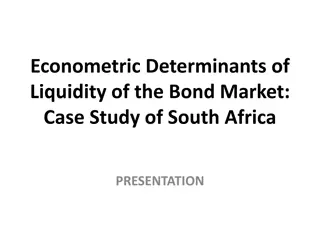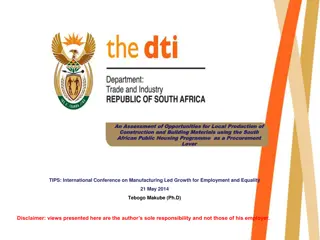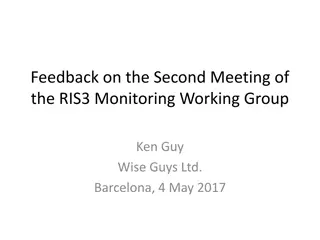Enhancing Compliance Monitoring in South African Public Service
The Compliance Monitoring Framework developed by the Office of Standards and Compliance aims to improve adherence to public administration norms and standards in South Africa. This framework is designed to reduce non-compliance through ongoing supervision, investigation, and promotion of proper behaviors. Legislative mandates and policy frameworks provide the foundation for monitoring and evaluating compliance within the public service, emphasizing the importance of integrating monitoring processes into management practices.
Download Presentation

Please find below an Image/Link to download the presentation.
The content on the website is provided AS IS for your information and personal use only. It may not be sold, licensed, or shared on other websites without obtaining consent from the author. Download presentation by click this link. If you encounter any issues during the download, it is possible that the publisher has removed the file from their server.
E N D
Presentation Transcript
DRAFT COMPLIANCE MONITORING FRAMEWORK Office of Standards and Compliance Department of Public Service and Administration (DPSA) November 2022 Growing South Africa together for a capable and ethical Public Service
PRESENTATION OUTLINE 2 Background and Purpose Legislative Mandate Public Administration Compliance M&E Function within the OSC Problem statement Compliance Monitoring Framework Recommendations Growing South Africa together for a capable and ethical Public Service 2
PURPOSE AND BACKGROUND 3 Section 17 of the Public Administration Management Act, 2014 established the Office of Standards and Compliance (OSC). One of the key functions of the OSC is to monitor and enforce compliance with public administration minimum norms and standards. In the 2021/2022 financial year the OSC developed a draft Framework for Monitoring of Compliance with Public Administration Legislative Framework (the Framework). The Framework seeks to strengthen the monitoring of public administration norms and standards in an effort to reduce non-compliance thereto by departments. Growing South Africa together for a capable and ethical Public Service 3
LEGISLATIVE CONTEXT 4 Legal Instrument Content Policy Framework for the GWMES The Policy Framework for the Government-Wide Monitoring and Evaluation System(GWM&E, 2007)is the overarching policy framework for monitoring and evaluation in the South African Government. It sketches the policy context for supporting frameworks, such as National Treasury's Framework for Managing Programme Performance Information (2007), Statistics South Africa's South African Statistics Quality Assurance Framework (SASQAF), and National Treasury's Performance Information Handbook (2011). It is crucial that managers understand and integrate the GWM&E framework into their management processes. Public Audit Act The Public Audit Act (2018) requires the Auditor General to audit performance information on an annual basis. The Public Audit Amendment Act provides for the Auditor-General to refer suspected material irregularities arising from an audit performed under this Act, to a relevant public body for investigation; Growing South Africa together for a capable and ethical Public Service 4
COMPLIANCE MONITORING 5 What does Compliance Monitoring mean? Compliance is understood as the adherence to laws, regulations and rules. Monitoring of compliance refers to the supervision and investigation conducted to track compliance; and seeks to encourage the right behaviours to promote compliance. Compliance monitoring identifies (on an ongoing basis), activities that are in breach of the law, conditions and authorisation and improperly authorised activities. In this context, compliance monitoring entails the identification of instances of poor or non-compliance with the minimum norms and standards. The main objectives of monitoring compliance are to: Obtain information consistently on the levels of compliance in terms of minimum public administration norms and standards and develop strategies for improvement Enable evidence-based decision making Assess performance in areas particularly critical to efficiency and effectiveness The Framework outlines the core compliance considerations, enablers and requirements towards compliance and an effective public service. Growing South Africa together for a capable and ethical Public Service 5
WHY THE NEED FOR COMPLIANCE MONITORING? 6 Non-compliance leads to irregularities in the administration and consequently affects the State s ability to provide optimal services. The failure to comply with legislation is one of the root causes of material non-compliance and audit findings (Consolidated General Report on National and Provincial Audit Outcomes, 2012/13- 2018/19, Auditor-General). The AG has consistently reported that much of this non-compliance was not detected by existing internal controls. According to AG findings, areas with higher non-compliance within the Public Administration relate to strategic planning and performance management. The OSC has also through its engagements identified particular transversal areas of non-compliance. The Framework therefore intends to foster and encourage compliance by guiding the monitoring of compliance with the minimum norms and standards particularly on issues that have an impact on the capacity of the state and would lead to improved quality of service delivery as well as ability of a public institution to perform and function effectively (if complied with). Growing South Africa together for a capable and ethical Public Service 6
PUBLIC ADMINISTRATION COMPLIANCE M&E FUNCTIONS 7 Manage Frameworks and Guidelines for the compliance monitoring and reporting Administration standards and Develop Manage Frameworks and Guidelines for the evaluation Administration standards and Develop of Public and of Public and norms norms Develop Early Warning System Manage the Provision of Implementation Support to Departments Develop annual compliance monitoring report quarterly and Growing South Africa together for a capable and ethical Public Service 7
CONCEPTUALIZATION 8 OF COMPLIANCE MONITORING FRAMEWORK 01 02 03 Summary Need for framework Objective Chapter 1 introduces the framework & outlines its objectives, the legal framework, and M&E principles. Chapter 2 looks at the theoretical framework for regulatory compliance; monitoring for compliance; and OSC feedback loop; unpacks challenges commonly experienced with regulatory compliance Chapter 3 deals with arrangements for PANS Compliance M&E. Covers roles & responsibilities for all aspects of compliance. Chapter 4 deals with governance mechanisms and arrangements within the compliance system; covers strategies to encourage compliance Chapter 5 is about how DPSA will monitor for compliance. Chapter 6 Methodology, including monitoring & assessment tools, and scoring criteria are discussed To comprehensive monitoring and evaluation of norms and standards as determined by the Minister for Public Service and Administration, in an effort to foster a compliance culture and reduce the risk of policy implementation failures in government. build a sound foundation for Section 17 of the PAMA requires the OSC to (b) promote and monitor compliance with minimum norms and standards determined by the Minister in relation to public administration management. For this function to be carried out properly, the OSC needs to develop frameworks to guide compliance monitoring and evaluation in government departments. the institutional It aims to assist, guide and support the OSC, DPSA and the entire public administration compliance monitoring systems, i.e. the development and implementation processes of compliance monitoring plans for all norms and standards determined by the Minister for the Public Service and Administration. Growing South Africa together for a capable and ethical Public Service 8
PRINCIPLES GOVERNING REGULATORY FRAMEWORK 9 GWME Framework Principles 1. M&E should contribute to improved governance Applicability Advancement of the principles of Transparency, Accountability, Participation and Inclusion Rights-based culture promoted in all M&E processes 2. M&E should be rights based Should consider and support key national, institutional and local development priorities 3. M&E should be development-oriented - nationally, institutionally and locally M&E must not compromise on issues of ethics and integrity 4. M&E should be undertaken ethically and with integrity Should meet expectations and aim for /support use of results 5. M&E should be utilisation oriented Sound, acceptable and appropriate methods are used 6. M&E should be methodologically sound Should be integrated within government systems, in a sustainable, cost-effective manner 7. M&E should be operationally effective Growing South Africa together for a capable and ethical Public Service 9
10 OSC COMPLIANCE MONITORING MODEL 1. SETTING COMPLIANCE REQUIREMENTS 2. PROMOTING COMPLIANCE 3. MONITORING COMPLIANCE REPORTING / COMMUNICATING RESULTS HOW DO WE RESPOND TO NON- COMPLIANCE? SUPPORT AND INTERVENTIONS 4. ENFORCING COMPLIANCE Growing South Africa together for a capable and ethical Public Service 10
THE FRAMEWORK 11 The framework recognises that full compliance with specific compliance areas or regulations may be difficult to achieve, unless- decision makers are supportive of improvement measures; or there is enforcement of consequences management. Therefore in an effort to promote regulatory compliance, the following factors will be considered when attempting to induce and promote the culture of compliance in the public administration- The degree to which the provincial and national departments are aware and understand the public administration legal framework; The degree to which the provincial and national departments are willing to comply - due to overall improved acceptance of the regulations and their goals, or pressure from enforcement activities and The degree to which the departments are able to comply. Growing South Africa together for a capable and ethical Public Service 11
13 SUMMARISED COMPLIANCE MONITORING PROCESS AS PER OSC REGULATIONS MONITOR OSC INVESTIGATES/AUDITS/ PROVIDES SUPPORT (ESTABLISH ROOT CAUSES OF NON-COMPLIANCE AND DEVELOP IMPROVEMENT PLAN WITH INSTITUTION) MATTER BROUGHT TO THE ATENTION OF THE OSC THROUGH DIRECT OR INDIRECT MEANS (EG. AGSA REPORTS; EWS; COMPLIANCE REPORTS) OSC REPORTS TO THE MPSA (INCLUDE DIRECTIONS ON STEPS TO BE TAKEN BY HEAD OF INSTITUTION (HOI) TO COMPLY) IMPLEMENTATION OF THE DIRECTIONS; INVESTIGATE REASONS FOR FAILURE TO IMPLEMENT, IF ANY SUBMIT A REPORT TO THE EA AND HOI WITH AN ENFORCEMENT RESPONSE PLAN (ERP) IF ORDER IS NOT COMPLIED WITH, REPORT TO THE MPSA, PARLIAMENT, RELEVANT EA, OPSC MONITOR ERP. IF NOT COMPLIED, OSC MAY ISSUE A COMPLIANCE ORDER Growing South Africa together for a capable and ethical Public Service 12
16 COMPLIANCE MONITORING CYCLE Growing South Africa together for a capable and ethical Public Service 13
14 ACHIEVING COMPLIANCE It is envisaged that the compliance monitoring mechanisms will encourage compliance and prevent violations/non-compliance. In this regard, a supportive rather than a sanctioning approach is important. A Compliance or Supportive approach is associated with cooperative, persuasive and self-regulatory strategies. The approach aims to prevent violations and secure long-term cooperative compliance by persuasion, negotiation, bargaining and education. This approach tends to rely on constructive and active engagements to get role-players to voluntarily comply, uncovering challenges, root causes and committing to resolve issues. The objective is to achieve compliance. Growing South Africa together for a capable and ethical Public Service Cooperation. Support. Interventions 14
15 PROPOSED STRATEGIES TO ENCOURAGE COMPLIANCE Identification and Creation of Compliance System - Policy , SOPs, Plans Assigning Roles and Responsibilities Awareness & Training Compliance Audit / Inspections Compliance Reporting Understanding Compliance Triggers Compliance Risk Classification Monitoring Mechanism Periodic Reviews Document Retention (Adapted from Ayres, I. & Braithwaite, 1992) Growing South Africa together for a capable and ethical Public Service 15
EARLY WARNING SYSTEM AS AN INTERGRAL PART OF COMPLIANCE MONITORING Monitoring and evaluation systems on public administration norms and standards should be build to serve as early warning systems (EWS), but those currently in place do not have the required characteristics and components of an EWS and, as a result, cannot provide early warning information to alert key players and stakeholders of developing problematic trends within the public administration. 17 The DPSA is in the process of appointing a service provider to develop an EWS. A compliance assessment methodology that involves determination of Early Warning Indicators (EWIs) will be used to pick up early signs of non-compliance. The EWS is expected to additionally reduce the reporting burden placed on institutions by creating one portal for information flow. Highlighting and issuing alerts on non-complying institutions will be one of the key activities of the EWS, which will be based on indicators. Based on a risk-based approach, the OSC will flag institutions in need of intervention/ support. Prioritisation will depend on other considerations such as whether a matter has been brought to the MPSA or OSC relating to an institution, Audit reports and media coverage. Institutions will also be able to submit their evidence of compliance electronically. Such evidence would consist of existing reporting infrastructure, including data, reports, reporting requirements, SOPs, reporting structures (the decision making architecture) and reporting mechanisms. All these will be utilised to monitor compliance with prescribed norms and standards; and analysis thereof will determine whether or not intervention is necessary Growing South Africa together for a capable and ethical Public Service 16
ROLES AND RESPONSIBILITIES 18 Role / Responsibility in ensuring compliance supports / promotes CM by developing Prescripts (Policies, Norms and Standards, Frameworks, Guidelines, etc.), to guide compliance monitoring within PA; providing implementation support. The OSC to ensure that systems are in place for monitoring of compliance; that right controls are in place to enhance compliance; ensure provision of accurate, timely information and data to DPSA/OSC Departments are to support departments, create an enabling environment for compliance The relevant executives to support implementation of PAMA Section 17: required to implement the requirements against those in contravention of the regulations to promote accountability and commitment to good governance. EAs Senior Managers and Team Leaders in charge of the policy/compliance areas identified) to plan, review the standards and to report on performance and implementation progress DPME, STATS SA & NSG (national departments who are well versed in the methodology), and OHSC to strengthen and work collaboratively with the DPSA to identify good practices, and build capacity Growing South Africa together for a capable and ethical Public Service 17
THANK YOU! Growing South Africa together for a capable and ethical Public Service 18
THANK YOU! THANK YOU! Growing South Africa together for a capable and ethical Public Service 19






